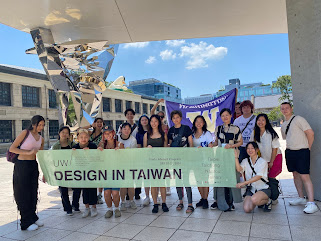While reading the students’ blogs in the morning of the presentation day at the Vision Base, I noticed how immersed they were in their design projects, with a submission deadline of 2:20 pm for the presentation files. As I began reading, the usual background noise—the scattered post-its, half-finished prototypes, and busy young designers—seemed to fade away. One student wrote, "I had stinky tofu (which was okay), but also the best mango of my life." I couldn’t agree more. To extend that Taiwan mango experience, I bought 5kg of dried Ai-Wen mango to bring back to Seattle.
The first three days of the program
have been packed with field trips, visits, and delicious food. Valentina at
Trash Kitchen even showed me a record of my visit from July last year, which
surprised me with how well they keep their records. We were connected through a
designer who worked at Miniwiz, the company behind Trash Kitchen. Later that
day, Kiki, the local coordinator, and I enjoyed an amazing éclair at Smille.
The clerk offered us free perilla plum tea with our order, refilled our bottles and served them in a cup to enjoy in their park-themed shop, complete with live
plant walls. It was a thoughtful touch, like many we’ve encountered during our
visits. At the Taiwan Design Research Institute (TDRI), we were given wireless
headsets during the tour to avoid disturbing the staff. The manager of Tai Hwa
Pottery took time from her lunch break to give us a factory tour. Everywhere we
go, the attention to detail is impressive—from drinking water dispensers everywhere to the NingXia night market's avoidance of disposable utensils.
The ACME restaurant at the Taipei Art Center was not only beautiful but offered
excellent food. Even though I’ve spent most of my life in Taiwan, I’m still
pleasantly surprised by the level of care and service.
A highlight for me was visiting Dot Design. Although I’ve been to places like the Songshan Cultural and Creative Park, the National Palace Museum, and Yingge Pottery Museum many times, this was my first visit to Dot Design, where I finally met Director Han. Years ago, I bought a tray made from recycled plastic and bamboo fabric, which I’ve kept in my office as an example of upcycle design for my class. Seeing their studio in person deepened my appreciation for their work. Dot Design doesn’t just promote sustainability—it makes it desirable. Their products, like cannoli stools reinforced with ribbing to compensate for degraded plastic, are not only eco-friendly but also aesthetically striking.
Seeing the students gather in the hotel lobby or Vision Base, full of excitement and energy, has been a joy. Travel can amplify personalities and tensions, sometimes creating conflicts. But so far, the group has remained positive, respectful, and engaged in all the activities. If we could work on punctuality a bit, things would run even smoother!
The design method we've been practicing is a structured yet spontaneous process. Unlike art, it takes various factors into account. Students are prompted with cultural references, found objects, and materials, with some groups even incorporating sustainability into their designs. Over 12 hours, the workshop is a design sprint, compressing discovery, definition, design, development, and delivery into a brief, intense experience. I’m curious how the non-design majors feel about having to build a prototype in half a day! Still, the results are impressive: from a shrimp lantern that’s simultaneously bold and kitschy to a turtle talisman compass that’s both functional and charming. The matching-making lights are flamboyant, while the chopstick and straw package pincher is a beautifully crafted object. The plastic tube chair is a great example of using found materials, and the spice containers’ unique designs resemble both numbers and spices. The professors at Shih Chien University were just as impressed, and we quickly agreed on the award recipients.
Our schedule in Tainan and Nantou will be more relaxed than in Taipei, allowing for longer visits and workshops over the next two weeks. The workshop at NCKU will have a different prompt, to be revealed in Tainan. Staying at the Tango Hotel has been a pleasure, and I hope to enjoy the hotel swimming pool on our day off.











Comments
Post a Comment